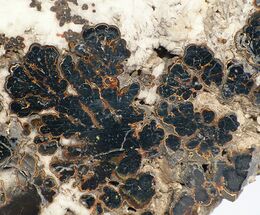Jordanite
 From Handwiki
From Handwiki | Jordanite | |
|---|---|
 | |
| General | |
| Category | Sulfosalt minerals |
| Formula (repeating unit) | Pb 14(As,Sb) 6S 23 |
| Strunz classification | 2.JB.30a |
| Crystal system | Monoclinic |
| Crystal class | Prismatic (2/m) (same H-M symbol) |
| Space group | P21/m |
| Identification | |
| Colour | Lead-grey |
| Cleavage | Perfect |
| Fracture | Conchoidal |
| Tenacity | Brittle |
| Mohs scale hardness | 3 |
| Metallic|re|er}} | Metallic |
| Streak | Black |
| Density | 6.4 |
| Pleochroism | Visible |
Jordanite is a sulfosalt mineral with chemical formula Pb
14(As,Sb)
6S
23 in the monoclinic crystal system,[2] named after the German scientist H. Jordan (1808–1887) who discovered it in 1864.
Lead-grey in colour (frequently displaying an iridescent tarnish), its streak is black and its lustre is metallic. Jordanite has a hardness of 3 on Mohs scale, has a density of approximately 6.4, and a conchoidal fracture.[2]
The type locality is the Lengenbach Quarry in the Binn Valley, Wallis, Switzerland .[2]
References
- ↑ Warr, L.N. (2021). "IMA–CNMNC approved mineral symbols". Mineralogical Magazine 85 (3): 291–320. doi:10.1180/mgm.2021.43. Bibcode: 2021MinM...85..291W.
- ↑ 2.0 2.1 2.2 Mindat information page for Jordanite
 |
Categories: [Sulfosalt minerals] [Lead minerals] [Monoclinic minerals] [Minerals in space group 11] [Arsenic minerals] [Antimony minerals]
↧ Download as ZWI file | Last modified: 02/02/2024 21:06:18 | 16 views
☰ Source: https://handwiki.org/wiki/Chemistry:Jordanite | License: CC BY-SA 3.0
✘
ZWI is not signed. [what is this?]

 KSF
KSF